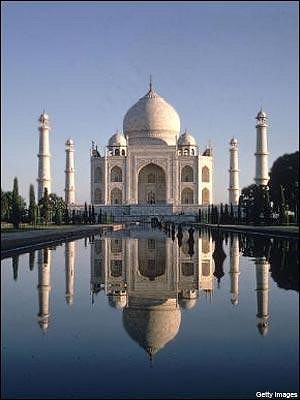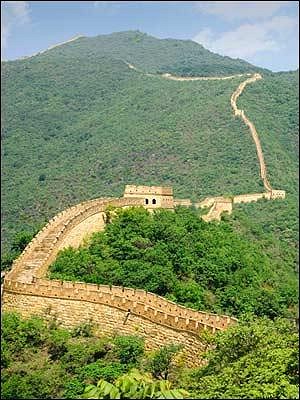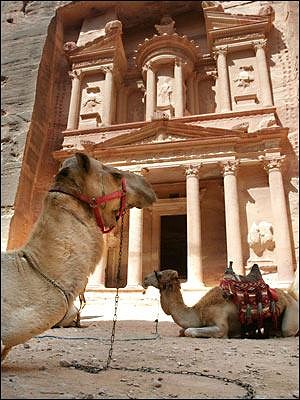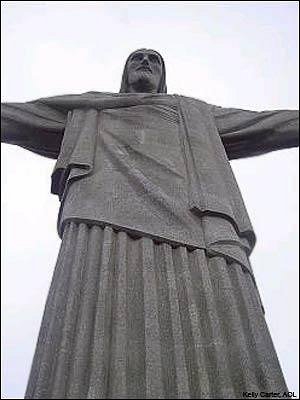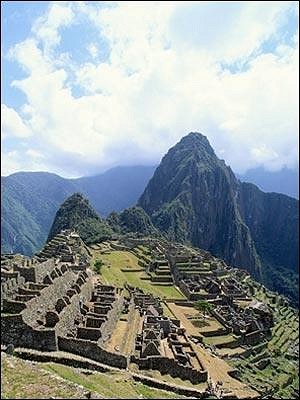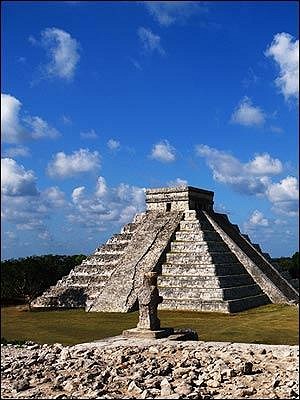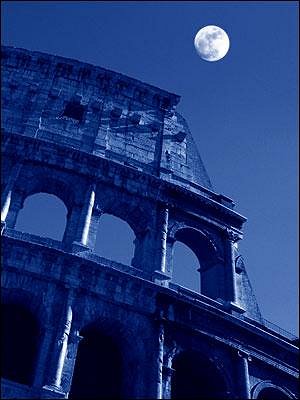Pages: 1 14 replies
|
J
johnnievelour
Posted
posted
on
Tue, Oct 17, 2006 1:48 PM
The Tikis are just one of 21 other wonders on the list for the New 7 Wonders of the World. You'll need to register |
|
V
VampiressRN
Posted
posted
on
Sun, Jan 28, 2007 5:54 PM
AOL & MSN have posted articles about voting for the new 7 wonders. Although not mentioned on AOL, but included in a picture was the Moais of Easter Island. They are included in the top 21 list in the MSN article. AOL ARTICLE Top Egyptian officials have lashed out at the popular contest that urges people around the world to vote for their top sites from a list of 21 finalists including the pyramids, Statue of Liberty, Taj Mahal, Eiffel Tower and Peru's Machu Picchu. The head of Egypt's Supreme Council of Antiquities, Zahi Hawass, recently said the "New 7 Wonders of the World" campaign had "no scientific or official stature." The pyramids are "living in the hearts of people around the globe, and don't need a vote to be among the world wonders," Hawass said, according to the state-run Middle East News Agency, or MENA. But contest organizers say the backlash in Egypt is unwarranted, claiming the competition's intentions are to renew international interest in culture and history, not strip the pyramids from their ancient status. "The controversy in Egypt has shocked us," said contest spokeswoman Tia B. Viering. "The contest is not about taking something away, it's about moving something into modern times." The Egyptian pyramids are the only surviving structures from the original list of seven wonders of the ancient world, that also included such places as the Hanging Gardens of Babylon and the Statue of Zeus at Olympia. Choosing new world wonders has attracted ongoing interest over the years, with the United Nations Educational, Scientific and Cultural Organization, UNESCO, list of World Heritage Sites includes 830 selections. Swiss adventurer Bernard Weber started the "New 7 Wonders of the World" in 1999, collecting nearly 200 nominations from all over the world to compete. That list was first whittled down to 77, before it was narrowed down to 21 by a panel of architectural experts, chaired by former UNESCO chief Federico Mayor. But Weber wanted the masses to pick the top seven, and opened the voting for the final round to the public. People can vote on the Internet, by phone or by sending a cell phone text message until July 6. The seven winners will be announced July 7 in Lisbon, Portugal, and half of the revenues raised by the campaign will go toward restoration efforts including the Bamiyan Buddha statue in Afghanistan , which was destroyed by the Taliban regime. As part of the campaign, Weber is visiting each of the 21 sites, which also include the Great Wall of China, the Sydney Opera House, Stonehendge and the Acropolis in Athens. Weber visited Egypt earlier this month for three days, but instead of receiving a warm welcome as he had during other stops on his world tour, he got the cold shoulder from Egyptian officials, who would not meet with him, Viering said. Weber tried to hold a press conference at a hotel near the pyramids, which are located on the outskirts of Cairo, but police shut it down, saying it was not authorized, she said. Egyptian officials also have made statements discounting the contest to local media over the past month. Egypt's Culture Minister Farouk Hosni called the competition "nonsense," saying it was "meaningless to vote on the pyramids" because they are the most important and most ancient wonder. The contest is "an attempt to seek celebrity and their efforts to meet Egyptian officials to give the contest significance won't take place. They have to understand the archaeological and the historical stature of the pyramids," MENA quoted Hosni as saying. The reception in Egypt was a stark contrast to the one Weber received in Jordan on Jan. 16 at that country's ancient city of Petra, also one of the 21 candidates. During his visit, a ceremony was held to declare Petra a contender, with Weber presenting Jordan's Queen Rania with the site's official candidacy at the event. Though the reception at other tour stops, including the Eiffel Tower and Moscow's Kremlin, was more subdued, Weber appears to also have been warmly greeted with ceremonies at other sites including the Taj Mahal in India, Angkor in Cambodia and the Kiyomizu Temple in Japan, according to his blog on the campaign's Web site. But the cool reception from Egyptian officials may not hurt the pyramid's chances of making it on the new list. With more than 24 million votes so far, Viering said the more than 4,000-year-old tombs are in the top seven. "We know that people all around the world want the pyramids as part of this as do people in Egypt," Viering said. "I think this controversy is a bump in the road, and I hope they will get over it." MSN ARTICLE Candidates for the new list have been narrowed down to 21, including the Eiffel Tower, Statue of Liberty, Taj Mahal and Peru's Machu Picchu. The public can vote until July 6, 2007, by Internet or phone. The seven winners will be announced July 7 in Lisbon, Portugal. Choosing world wonders has been a continuing fascination over the centuries. The United Nations Educational, Scientific and Cultural Organization, or UNESCO, keeps updating its list of World Heritage Sites, which now totals 830 places. The "New 7 Wonders of the World" campaign was begun in 1999 by Swiss adventurer Bernard Weber, with almost 200 nominations coming in from around the world. Weber "felt it is time for something new to bring the world together" and to "symbolize a common pride in the global cultural heritage," said Tia B. Viering, spokeswoman for the campaign.
Weber's Switzerland-based foundation aims to promote cultural diversity by supporting, preserving and restoring monuments. It relies on private donations and revenue from selling broadcasting rights. Nominations were whittled down by public votes to 77 last year. Then a panel of architectural experts, chaired by former UNESCO chief Federico Mayor, shortened the list to 21. Interest has grown as Weber and his 10-member team visit the 21 sites. Their final visit will be March 6 to New York's Statue of Liberty. In addition to the Statue of Liberty, Pyramids, Eiffel Tower, Taj Mahal and Machu Picchu, the finalists are the Acropolis; Turkey's Haghia Sophia; the Kremlin and St. Basil's Cathedral; the Colosseum; Germany's Neuschwanstein Castle; Stonehenge; Spain's Alhambra; the Great Wall; Japan's Kiyomizu Temple; the Sydney Opera House; Cambodia's Angkor; Timbuktu; Petra, Jordan; Brazil's Statue of Christ Redeemer; Easter Island; and Chichen Itza, Mexico. To vote, go to http://www.new7wonders.com or call (011) 372-541-11738 or (011) 423-663-900299. (International phone rates apply.) Here are descriptions of the 21 candidates. Acropolis, Greece: A million people come here each year to see the marble temples—including the ruins of the columned Parthenon—and statues of Greek gods and goddesses dating from the fifth century B.C. Alhambra, Spain: The palace and citadel, perched above Granada, was the residence of the Moorish caliphs who governed southern Spain in splendor until 1492, when the city was conquered by the Christian forces of King Ferdinand and Queen Isabella, ending 800 years of Muslim rule. Stunning features include mosaics, arabesques and mocarabe, or honeycomb work. Angkor, Cambodia: The archaeological site in Siem Reap was the capital of the Khmer (Cambodian) empire from the ninth to 15th centuries. It served as administrative center and place of worship for a prosperous kingdom that stretched from Vietnam to China and the Bay of Bengal. The 12th century ruins include Angkor Wat and Angkor Thom. Christ Redeemer Statue, Brazil: The 125-foot statue of Christ the Redeemer with outstretched arms overlooks Rio de Janeiro from atop Mount Corcovado. The statue was built in pieces in France starting in 1926, and shipped to Brazil. A railway carried it up the 2,343-foot mountain for the 1931 inauguration. Colosseum, Italy: The 50,000-seat amphitheater in Rome was inaugurated in A.D. 80. Thousands of gladiators dueled to the death here. The arena has influenced the design of modern stadiums. Easter Island, Chile: Hundreds of massive stone busts, or Moais, are all that remains from the prehistoric Rapanui culture that crafted them between 400 and 1,000 years ago to represent deceased ancestors. Some statues are over 70 feet tall. Eiffel Tower, France: The 985-foot tower, built in 1889 for the International Exposition, symbolizes Paris. Made almost entirely of open-lattice wrought iron and erected in only two years with a small labor force, the tower—Paris' tallest structure—demonstrated advances in construction techniques, but some initially criticized it as unaesthetic. Great Wall of China: The 4,160-mile barricade running from east to west is the world's longest man-made structure. The fortification was built to protect various dynasties from invasion by Huns, Mongols, Turks and other nomadic tribes. Construction took place over hundreds of years, beginning in the seventh century B.C. Hagia Sophia, Turkey: The soaring cathedral, also called the Church of Holy Wisdom, was built in 537 A.D. at Constantinople, today's Istanbul. In 1453, when Constantinople fell to the Ottomans, it became a mosque with minarets. When Turkish President Kemal Ataturk turned it into a museum in 1935, Christian mosaics covered up by the Muslims were revealed. Kiyomizu Temple, Japan: Kyoto's Kiyomizu-dera, which means Clear Water Temple, was founded by a Buddhist sect in 798 and rebuilt in 1633 after a fire. Drinking from its three-stream waterfall is believed to confer health, longevity and success. Kremlin and St. Basil's Cathedral, Russia: Onion domes with golden cupolas surrounded by red brick walls are at the heart of Moscow's Kremlin, a Medieval fortress converted into the center of Russian government. The Kremlin once symbolized Soviet communism. The Cathedral of St. Basil the Blessed on adjacent Red Square features nine towers of different colors. It was built by Czar Ivan the Terrible in the mid-16th century. Machu Picchu, Peru: Built by the Incan Empire in the 15th century, Machu Picchu's walls, palaces, temples and dwellings are perched in the clouds at 8,000 feet above sea level in the Andes overlooking a lush valley 310 miles from Lima. Neuschwanstein Castle, Germany: The inspiration for the Sleeping Beauty Castle at Disneyland, Neuschwanstein is a creation of "Mad King" Ludwig II of Bavaria, who had it built in the 19th century to indulge his romantic fancies. Perched on a peak in the Bavarian Alps, the gray granite castle rises to towers, turrets and pinnacles and contains many paintings with scenes from Richard Wagner operas admired by Ludwig. Petra, Jordan: This ancient city in southwestern Jordan, built on a terrace around the Wadi Musa or Valley of Moses, was the capital of the Arab kingdom of the Nabateans, a center of caravan trade, and continued to flourish under Roman rule after the Nabateans' defeat in A.D. 106. The city is famous for water tunnels and stone structures carved in the rock, including Ad-Dayr, "the Monastery," an uncompleted tomb facade that served as a church during Byzantine times. Pyramid at Chichen Itza, Mexico: This step pyramid surmounted by a temple was part of a sacred site in an important Mayan center on Mexico's Yucatan peninsula. It is built according to the solar calendar. Shadows at the fall and spring equinoxes are said to look like a snake crawling down the steps, similar to the carved serpent at the top. An older pyramid inside features a jade-studded, red jaguar throne. Pyramid of Giza, Egypt: The only surviving structures of the original seven wonders, the three pyramids were built as tombs for pharaohs 4,500 years ago. Nearby is the Great Sphinx statue, with a man's face and a lion's body. Statue of Liberty, New York: The 305-foot statue in New York Harbor has welcomed immigrants and symbolized freedom since 1886, when it was dedicated as a gift of the French government. Stonehenge, Britain: How and why this circular monument of massive rocks was created between 3,000 and 1,600 B.C. is unknown, but some experts say the stones were aligned as part of a sun-worshipping culture or astronomical calendar. Today it is a major tourist attraction. Druids and New Age followers gather here every June 21 to celebrate summer solstice. Sydney Opera House, Australia: Situated on Bennelong Point reaching into Sydney's harbor, the opera house was designed by Danish architect Jorn Utzon and opened in 1973 by Queen Elizabeth II. Its roof resembles a ship in full sail and is covered by over 1 million white tiles. The building has 1,000 rooms. Taj Mahal, India: The white marble-domed mausoleum in Agra was built by a 17th century Mogul emperor for his favorite wife, who died in childbirth. The architecture combines Indian, Persian, and Islamic styles. The complex houses the graves of the emperor, his wife, and other royalty. Timbuktu, Mali: Two of West Africa's oldest mosques, the Djingareyber, or Great Mosque, and the Sankore mosque built during the 14th and early 15th centuries can still be seen here in the northern Sahara Desert. Founded about A.D. 1,100, Timbuktu was a flourishing caravan center in the Arabic world and a leading spiritual and intellectual center in the 15th and 16th centuries, with one of the world's first universities. |
|
J

JenTiki
Posted
posted
on
Fri, Mar 30, 2007 11:27 AM
There are some great photos and video of the "7 wonders" world tour visit to Rapa Nui here. |
|
V
VampiressRN
Posted
posted
on
Sun, Jul 8, 2007 1:13 PM
Unfortunately the new 7 wonders of the world does not include Easter Island. They are as follows: ~ The Taj Mahal in India ~ The Great Wall of China ~ Petra in Jordan ~ Christ Redeemer in Rio De Janeiro, Brazal ~ Machu Picchu in Peru ~ Chichen Itza in Mexico ~ The Roman Colosseum in Italy |
|
H
HelloTiki
Posted
posted
on
Sun, Jul 8, 2007 10:55 PM
Where's Sophia Loren? |
|
V
VampiressRN
Posted
posted
on
Sun, Jul 8, 2007 11:21 PM
:lol: Yeah...where is George Clooney. :) I am kinda pissed that Easter Island didn't make it. :( |
|
J
juke
Posted
posted
on
Mon, Jul 9, 2007 11:00 AM
Thanks for the info! |
|
A
arriano
Posted
posted
on
Mon, Jul 9, 2007 1:58 PM
I really disagree with the inclusion of at least three of these -- especially Chichen Itza. I've been there, and it is impressive. But either Teotihuacan or Tikal would have been better choices. And don't even get me started on choosing the Christ the Redeemer statue over all the Easter Island statues. |
|
C
cheekytiki
Posted
posted
on
Mon, Jul 9, 2007 2:21 PM
Yeah, France should have gotten something for the Statue of Liberty :) |
|
P
Paipo
Posted
posted
on
Mon, Jul 9, 2007 2:38 PM
I'm stoked Easter Island didn't make it. From what I understand, a huge increase in tourist numbers is the last thing they need at the moment without some serious conservation planning and funding. Who needs hordes of ignorant tourists descending on the island who have little interest in the history or culture, but are just stopping in to check it off their "7 Wonders" list?
[ Edited by: Paipo 2007-07-09 19:45 ] |
|
V
VampiressRN
Posted
posted
on
Mon, Jul 9, 2007 6:35 PM
Thanks for sharing that....it just might be a blessing it didn't get caught up in the insanity of famous touristy places. Always good to look at the other side of the coin....sometimes it has a deeper meaning than the obvious. |
|
T

twitch
Posted
posted
on
Mon, Jul 9, 2007 9:03 PM
I'd have to agree. Although the price tag on getting out there is prohibitive enough already! |
|
I
ikitnrev
Posted
posted
on
Tue, Jul 31, 2007 2:39 PM
Reason Magazine had a good article on the dilemna facing Easter Island - whether more tourism is good or bad. http://reason.com/news/show/121390.html Things I did not know ...
Vern |
|
P

PiPhiRho
Posted
posted
on
Tue, Jul 31, 2007 4:01 PM
Tourism not withstanding, I think both Stonehenge and the Moai of Rapa Nui deserve to be counted as "7 Wonders" more than the Taj Mahal and Christ the Redeamer statue. While both are certainly impressive structures, it is well known how they were built and no one has suggested that space aliens and/or levitation were involved in their construction. But perhaps I interpret the word "wonder" a bit too narrowly. |
|
TG
The Gnomon
Posted
posted
on
Thu, Aug 2, 2007 7:03 AM
The Rebuilding of Stonehenge kind of detracts from its appeal as a Wonder of the World. Perhaps, had it been left in ruins things might have been different. As it stands now, though, there is no mystery to the astronomical alignments. They were all assumed by the archaeologists who took part in the reconstruction, so it was rebuilt with 20th Century insight as to how the stones should be aligned.
On the left is the way it looked as ruins before people started meddling with it (John Constable painting 1835). On the right is the completed makeover. |
Pages: 1 14 replies

